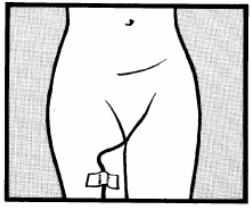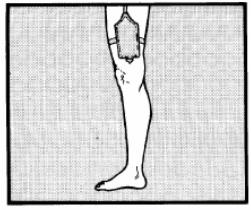
|
|
Lesson 3: Catheterization of the Male and Female Patient
3-7. INSERTING THE FOLEY CATHETER IN A FEMALE PATIENT
The following procedures are used to insert the Foley catheter in a female patient.
a. Wash the area around the meatus with warm soap and water. Rinse and dry.
b. Wash your hands.
c. Open the sterile catheterization kit, using sterile technique.
d. Put on sterile gloves.
e. Place the fenestrated drape on the patient with the hole over the female genitalia.
f. Apply sterile lubricant liberally to the catheter tip. Lubricate at least three inches of the catheter for the female. Leave the lubricated catheter over the cotton balls.
g. Place the urine specimen collection container within reach.
h. Place the thumb and forefinger of your nondominant hand between the labia minora, spread and separate upward. The gloved hand that has touched the patient is now contaminated.
i. Using the forceps, pick up a cotton ball saturated with antiseptic solution. Use one cotton ball for each stroke. Swab from above the meatus downward toward the rectum.
j. Keeping the labia separated, cleanse each side of the meatus in the same downward manner (figure 3-5). Do not go back over any previously cleansed area.
k. Deposit each cotton ball into the disposal bag. After the last cotton ball is used, deposit the forceps into the bag as well.
l. Continue to hold the labium apart after cleansing. Insert the lubricated catheter into the female patient's urinary meatus (figure 3-6).
m. Angle the catheter upward as it is advanced. If the catheter will not advance, instruct the patient to inhale and exhale slowly. This may relax the sphincter muscle. Do not force the catheter.
n. When urine starts to flow, insert the catheter approximately one inch further. Place the cup under the stream of flowing urine to obtain a sterile specimen if required.
o. Hold the catheter in place while the urine drains into the collection container.
NOTE: If the catheter is inadvertently placed in the patient's vagina, leave it in place temporarily. Insert another catheter properly by repeating the entire procedure using another sterile set; then remove the catheter from the vagina.
p. Attach the syringe to the balloon port of the catheter. Inject the water slowly to inflate the balloon. If the water will not inject easily or the patient complains of pain, deflate the balloon completely and advance the catheter further, then re-inflate.
q. Remove the syringe. To position the balloon correctly, pull on the catheter gently until you feel resistance.
r. Connect the drainage bag to the catheter. Secure the catheter to the inner aspect of the female patient's thigh (figure 3-7).
s. Attach the urinary drainage bag to the bed, below the level of the bladder but off the floor. Coil any extra tubing on the bed.
t. Remove any lubricant or antiseptic on the patient's skin. Remove your gloves, the drapes and the Chux® from around the patient.
u. Discard disposable equipment and return reusable equipment to the appropriate area.
v. Record the time that the procedure was done and by whom, the patient's reaction to the procedure, all patient teaching done, and the patient's level of understanding. Report observations to the charge nurse to include:
(1) The amount, color, and clarity of the urine.
(2) Any difficulty with the procedure.
(3) The presence of blood in the urine.
3-8. MAINTAINING AN INDWELLING CATHETER
When an indwelling or retention catheter is inserted, the nurse is responsible for the daily care required to maintain proper drainage and reduce the possibility of an infection occurring. Always have a confident, reassuring, and professional attitude when maintaining the catheter so that the patient will not feel embarrassed.
a. Wash your hands before and after caring for the patient and wear gloves when handling an indwelling catheter.
b. Clean the perineal area with soap and water twice daily and after each bowel movement, especially around the meatus. Use a separate area of the cloth for each stroke.
c. In some cases, an antiseptic may be used for perineal care. Povidone iodine (Betadine) is most commonly recommended.
d. Avoid use of lotions or powder in the perineal area.
e. Arrange for the patient to take a shower or tub bath when permitted. The collecting container may be hung over the side of the tub. The catheter should be clamped temporarily if the collecting container is higher than the bladder.
f. A leg bag (figure 3-8) may be worn in the shower. This device allows the ambulatory patient to move about freely and dress in his usual clothing. Keep the tubing intact and free of kinks.
g. Open the port at the bottom of the urinary collecting bag. This permits all the connections and tubing between the catheter and drainage device to remain closed while permitting you to measure and dispose of accumulated urine.
h. Teach the patient to maintain the catheter. Self-care helps the patient develop a feeling of independence and promotes cleanliness. If the patient is ambulatory, instruct him in use of the leg bag. Encourage the patient to intake 2500 cc to 3000 cc of fluid daily.
i. Change the indwelling catheter as necessary or in accordance with local policy.
3-9. IRRIGATING AN INDWELLING CATHETER
The purpose of irrigating a catheter is to remove particles that are interfering with the drainage of urine. A catheter that drains well does not need irrigating, except to instill medication. If the patient has a generous fluid intake (2500 cc to 3000 cc of fluid daily), the increase in urine production will dilute the particles that form and irrigate the catheter naturally; thus, invasive procedures may be avoided. Because the drainage system is opened when irrigation takes place, sterile technique is followed.
a. Gather sterile supplies and equipment:
(1) Asepto syringe.
(2) Basin.
(3) Tubing protector.
(4) Gauze moistened with antiseptic.
(5) Sterile normal saline (or other irrigation solution).
b. Using gauze moistened with antiseptic solution, wipe the area where the catheter and tubing join.
NOTE: Some catheters have a self-sealing port with a separate lumen through which irrigation solution may be instilled (see figure 3-9). This allows irrigation without separation of the catheter from the collecting device and reduces the possibility of contamination.
c. Place the sterile tubing protector on the end of the drainage tubing. An alternative is to cover the opening with sterile gauze moistened with antiseptic.
d. Fill the syringe with 30 to 60 cc of solution and insert the syringe tip well into the end of the catheter.
e. Gently compress the ball or end of the syringe to instill the irrigating solution. Do not apply force. Replace the catheter if it cannot be irrigated.
f. Allow the instilled solution to flow back into the basin by gravity.
g. Connect the catheter and drainage tube.
h. Note the total amount of solution used for irrigating and measure the amount of solution returned in the basin. In some cases there is less solution returned than solution instilled. Both amounts must be recorded. The amount that remains will eventually drain into the collection bag.
i. Discard the solution drained into the basin. Replace or protect the irrigating equipment.
j. Record that the irrigation was done, by whom, and the patient's response to the procedure.
3-10. REMOVING AN INDWELLING CATHETER
Eventually, a catheter must be removed because the need for it no longer exist or it is crusting and must be changed. The nurse usually removes the catheter.
a. Assemble all supplies and equipment.
(1) 10 cc syringe.
(2) Washcloth and towel.
(3) Exam gloves.
(4) Soap and water.
(5) Chux®
b. Identify the patient and explain the procedure to him. Advise him that there will be a slight burning during removal of the catheter.
c. Provide privacy and assist the female patient into a dorsal recumbent position. The male should be in a supine position. Place Chux® under the patient's buttocks and provide proper draping.
d. Wash your hands and put on exam gloves.
e. Empty the balloon by inserting the barrel of the syringe and withdrawing the amount of fluid used during inflation.
f. Pinch off and gently pull on the catheter near the point where it exits from the meatus.
g. Clean the perineum or penis with soap and water. Dry the area well.
h. Inspect the catheter to be sure no remnants remained in the bladder. If the catheter is not totally intact, report this promptly and save the catheter for further inspection.
i. Empty the drainage bag. Measure the amount of urine and record on the intake and output (I&O) sheet.
j. Remove the gloves and wash your hands.
k. Discard disposable supplies and return reusable supplies and equipment to the appropriate area.
l. Record that the catheter was removed, the time and date and by whom. Note the amount, color, and clarity of the urine in the drainage bag. Also document all patient teaching done and the patient's level of understanding.
m. After removal of the catheter, assess the patient for 24 hours for patterns of urinary elimination. Note the time and amount of the first voided urine. Report any of the following:
(1) Inability to void within 8 to 10 hours.
(2) Frequency, burning, dribbling, or hesitation in starting the stream of urine.
(3) Cloudiness or any other unusual color or characteristic of the urine.
n. Provide a level of fluids similar to the intake when the catheter was in place.
o. Record that the catheter was removed, the date and time, and by whom.
Catheterization can be done without embarrassment and with little discomfort for both the male and female patient. Your observation of urinary output and characteristics of the urine aids in early detection of infection or any other complications. Always remember, you are accountable for responsible care and the safety of the patient.




